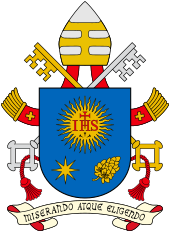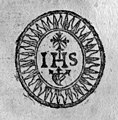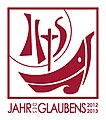IHS
The noun sacrum IHS is derived from the first three letters of the name Jesus in Greek capital letters , Ι Η Σ Ο Υ Σ , where the sigma is replaced by a Latin S.
distribution
IHS (and ihs) as the short form of the name Jesus can be found very often in Bibles from the Middle Ages and elsewhere. Until about 1450, the words Jesus, Christ and other nouns sacra were practically never written out in Bibles and documents . At first the abbreviation IHS was provided with an abbreviation line above it, which later became a cross. This short form is used in the late Middle Ages and especially since its foundation by the Society of Jesus . The monogram is also often found as an ornament on churches or on paraments . Typical for the late Middle Ages is the attachment of the Jesus monogram in a halo, which symbolizes the shine emanating from the body of Christ .
Tangled IHS in Saint-Martin de L'Isle-Adam
The IHΣ on the Reformation Monument in Geneva
IHS at a former Jesuit church in Dubrovnik (Ragusa)
IHS on the tabernacle of St. Georg in Hollerberg
IHS in the logo for the year of faith 2012/13
Locumtenenstaler Frederick the Wise . IHS: MARIA can be read on the harness.
Noun sacrum IHS on a loaf of bread from the Plankstetten monastery bakery
variants
In order to enable fluent reading of the Bible text, the Latin case ending was often added. IHV for Jesu (genitive, dative, vocative and ablative) and IHM for Jesum (accusative) appear in some scriptures . The same applies to XPC , later XPS (Chi-Rho-Sigma) as a short form for the Greek form of the word Christ (German: Anointed ; Hebrew: Maschiach , Latinized: Messiah ).
history

In older (medieval) spellings, further attributes are missing, including the cross, which in Fraktur is sometimes indicated by a cross in the left (higher) vertical line of the "H". Later the monogram seems to have been extended to include such. It is sometimes hypothesized that the "V" was placed under the IHS. As a rule, however, nails can be found there, which would then correspond to a reinterpretation of the "V", and the number increased to three - at least three nails were required for the crucifixion - and provided with a heart or other attributes, as in numerous depictions can be seen in farmhouses, churches and other places. The house inscription in the Höxter district and on an altar in Kenzingen should also be interpreted in this way.
These symbols were also reinterpreted on a case-by-case basis; The Jesuits sometimes interpret the three nails as symbols for the three fundamental evangelical counsels of poverty, celibacy and obedience .
interpretation
A popular interpretation for IHS is - among several others - in German also "Jesus, Heiland , Seligmacher" (see also ICHTHYS ). The Latin reading Iesus Hominum Salvator ("Jesus, the savior of men") is also widespread . B. used Bishop Walter Mixa as his motto. With the Jesuits , the symbol is interpreted as a short form of Iesum Habemus Socium ("We have Jesus as a companion").
In addition, the dream of the Emperor Constantine before the battle of the Milvian Bridge against Maxentius in 312 is mentioned: In hoc signo vinces (“Under this sign you will win”). A ligated XP ( Christ monogram ) or XPI (for Chi-Rho-Iota ) , on the other hand, is regarded as the actual Constantinian Christ monogram, which is very common in early Christianity.
The abbreviation IHS or JHS played an important role in the worship of the Name of Jesus, for which the Franciscan St. Bernard of Siena had advocated in the 15th century. In this context, the name of Jesus festival was introduced later .
heraldry

In heraldry , the three letters are a common figure and thus a coat of arms figure . All tinctures of the heraldic art are allowed. The rules for letters in heraldry apply . The rule for coat of arms color must be observed: no color on color or metal on metal. The coat of arms figure can be combined with other figures in the shield or field . A halo, if available, is to be indicated in the blazon . The cross can, if present, be connected to a letter or float above it.
See also
literature
- Ludwig Traube : Nomina sacra. Attempt to create a history of Christian shortening (= sources and studies on the Latin philology of the Middle Ages. 2, ISSN 0721-6203 ). Beck, Munich 1907, e.g. B. pp. 149-297. , (Unchanged reprographic reprint. Wissenschaftliche Buchgesellschaft, Darmstadt 1967).








